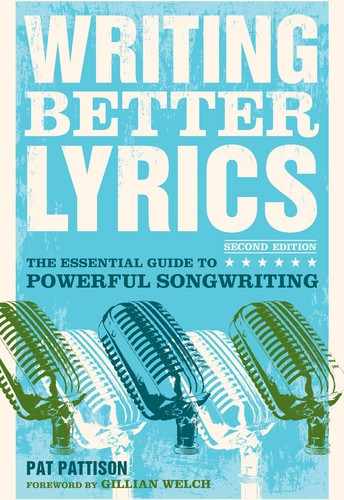INTRODUCTION
I'm very happy that songwriters have found Writing Better Lyrics helpful, and I'm grateful to be writing an introduction to a second edition. It's been a while since the first publication in 1995, and I've learned a lot since then, thanks to my students at Berklee College of Music and the many songwriters I've met and worked with both in my traveling seminars and my online courses. Each time I teach, I learn something new from them — a real blessing in my life to be on such a journey.
This edition has added almost one hundred new pages and has INTRODUCTION expanded and revised some of the existing chapters.
I've enlarged the opening chapter on object writing with new (and, I think, more helpful) examples. Over the years, this exercise has proved to be a mainstay for many successful songwriters, including Grammy winners John Mayer and Gillian Welch. The additional material in this chapter incorporates some new and interesting ways to approach object writing, making it an even more useful way to brainstorm, open your senses, and discover unique ideas for your songs.
The chapters on verse development add examples and new material, introducing the concept of “boxes,” which students over the years have found helpful. I think you will, too.
I've found an interesting and, I hope, helpful way of thinking about rhymes, treating them the way you treat chords in a song. It provides a clearer view of rhyme's function and will help you choose rhyme types for a reason.
The chapters on point of view also have a new look and suggest some interesting ways to approach the process of finding the right perspective for your song.
I've added several new chapters that reflect work I've been doing since the first publication of Writing Better Lyrics. There's a chapter on the productive use of repetition, a chapter on showing and telling, and several “in the trenches” chapters on structure to help you make more informed decisions while in the heat of writing.
There are two new chapters on handling couplets and common meter. Each will take you through a series of expansions and manipulations of these structures to show you some new options and possibilities, while still keeping to familiar territory.
I've also added a chapter on prosody, the most fundamental principle of songwriting and, indeed, of art in general: the concept that all the elements of a song — chords, melody, rhythm, words, and lyric structure — should work together for a common purpose.
The centerpiece of this new material is the chapter called “Understanding Motion,” which explores the intersections of rhythm, rhyme, and phrase length, and their use in creating prosody, which is support for the ideas and emotion of the lyric. Motion creates emotion; knowing how to make structures move allows you to support your ideas on a whole new level. The chapter can also be used as a reference guide to stable and unstable structures.
I hope this edition will be helpful in making your lyrics work harder and better.
Write fearlessly. Have fun.
Pat Pattison, February 2009
